 |
|

| |
|
Folk Ceramics
In the Middle Ages pottery guilds already worked in Gyula. The Ottoman Occupation left brilliant craftsmanship in our region as all over the Great Plains. Our county is the connection point of the pottery centres (Hódmezővásárhely and Mezőtúr) which are artistically determining. In the first half of the 19th century the communities of the firmly established and urbanizing peasant estates had the requirements of their own potter’s craft. The people in Tótkomlós and Csaba went to Vásárhely, the ones in Szarvas and Berény entered service as apprentices in Mezőtúr in terms of regional attractions. Békéscsaba and Tótkomlós had specific forms, colours and motifs adjusting to the local taste; most efficiently in Tótkomlós where six or eight potters worked by the middle of the 19th century and created a formal representation, like special pots (komatál) and chimney ornaments in their workshops as the development of the technology of Vásárhely. The most popular colour combinations of the ceramics in Tótkomlós are black, red, green and yellow that is in harmony with the Slovakian home textiles and costumes. Their typical blossoms made furrier motifs live longer. Characteristic ornaments prevailed on bottles: the Slovakian writing and the divided dark and light toned halves of life tree, the motifs of cocks and leaves were framed by escutcheon. On the bottles of Szarvas, that has relations with the bottles of Mezőtúr, Slovakian and Hungarian writing can be read. The most beautiful green enamelled bottles of Csaba have flower and relieflike ornaments. On the pieces made for either Slovakian or Hungarian customers the Slovakian word "year" (roku) was indicated. The mixed styled pottery of the turn of the century showed the weakening of traditions. In the second half of the 20th century folk industrial artists got back to the roots of the profession, such as Tóth István in Szarvas evoked the figure world of the traditional folk ceramics.
|
| | 
|
| |
"bottle, ""butella"""
"Origin: Tótkomlós Technique: Green glazed, deepened, black flowers, with Slovakian wriring: ""1887 Bites János"" Size: H: 20 cm Bottom: 8 cm" |
|
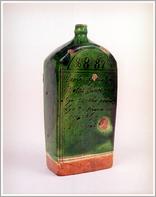

| | 
|
| |
"bottle, ""butella"""
"Origin: Nagylak Technique: Prismatic, green glazed, narrow pouring lip. Flower leaning out of a basket on one wide side, cock above, ""1885"" engraved in an arched frame, Hungarian and Slovakian writing on the other side, ""Pipis György Nagylakon Készült"" Size: H: 23 cm Bottom: 11 cm" |
|
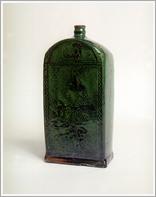

| | 
|
| |
"bottle, ""butella"""
"Origin: Szarvas Technique: Book-shaped, glazed light geren, applied, engraved cross stripes and writing at the front: ""Antal Jánosé ifiú Ez az Butela Szarvason"" Size: H: 14 cm W: 5 cm W: 10 cm" |
|


| | 
|
| |
"bottle, ""butella"""
"Origin: Tótkomlós Technique: Green-glazed, geometrical and black stylized flower motifs engraved, Writing: ""1885 Bugyinski Mihály"" Size: H: 22 cm Bottom: 9.5 cm" |
|
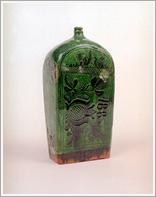

| | 
|
| |
"bottle, ""butella"""
"Origin: Tótkomlós Technique: Prismatic, with wide rounded shoulders, brown glazed at the bottom, rose on the narrow side, framed writing: "" Bodor Pál Roku Pane 1876"" Size: H: 21 cm Bottom: 8.5 cm" |
|
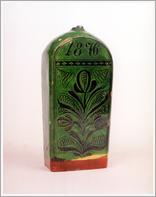

| | 
|
| |
"bottle, ""butella"""
"Origin: Tótkomlós Technique: Prismatic, with wide rounded shoulders, double stripes on the neck, narrow pouring lips, deepened bird and flower motif, Slovakian writing,""Pekna butyelya je moje meno ked jeszto vomnye palyeno tobi mijelyem csrep meno Vivat"" ""Tato butelya pri nalyez Ondrejo Palyovi Roku Panye 1879"" Size: H: 23 cm bottom: 10 cm" |
|
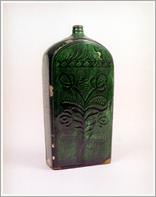

| | 
|
| |
"bottle, ""butella"""
"Origin: Tótkomlós Technique: Prismatic, with wide rounded shoulders, green glazed, writing: ""Bobor Pál Roku pane 1876"" Size: H: 23 cm Bottom: 10 cm" |
|
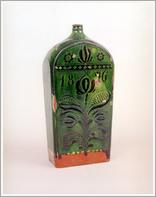

| | 
|
| |
"bottle, ""butella"""
"Origin: Tótkomlós Technique: Green glazed, deepened, black stylized flowers, engraved geometrical ornaments with Slovakian wriring. Writing on the other side: ""Ponyiczki Mihály 1892"" Size: H: 22 cm Bottom: 10 cm" |
|
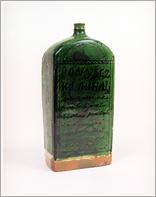

| | 
|
| |
"bottle, ""butella"""
"Origin: Nagylak Technique: On the two narrow sides tree of life, writing: ""Gombos Mátyás Készült Nagylakon 1893"" and""Fábry István Nagylaki '893 Juniusz 5"" Size: H: 20.5 cm width of the bottom: 5.5, Bottom: 7 cm" |
|
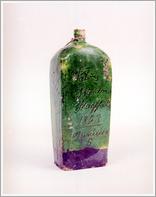

| | 
|
| |
"dish, ""vajling"""
"Origin: Békéscsaba Technique: Effects of Mezőtúr, ""dudi""coloured (light beige) ceramic pot with wide orifice and flowers on the side and the bottom. Size: H: 20.5 cm Orifice: 53 cm bottom: 22 cm" |
|


| | 
|
| |
"mug, ""sinár"""
Origin: Tótkomlós Technique: Green glazed, con vex ornament round on the side, facing angels, birds on the lid. Size: H: 20 cm Bottom: 10 cm |
|
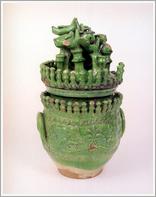

| | 
|
| |
"pitcher with a narrow neck ""butykos"""
Origin: Békéscsaba Technique: Dark brown glazed, with yellow ornaments drawn with a stick, one handled ceramic pot. Size: H: 26 cm Bottom: 9 cm |
|
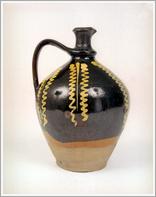

| | 
|
| |
"pitcher with a narrow neck ""butykos"""
Origin: Békéscsaba Technique: Green glazed, one handled ceramic pot with black ornaments drawn with a stick. Size: H: 30 cm Bottom: 11 cm |
|
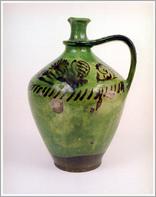

| | 
|
| |
"pitcher with a narrow neck ""butykos"""
"Origin: Tótkomlós Technique: Dark brown glazed, ornamented with white wavy lines, red glazed at the bottom, writing: ""1908"" Size: H: 28 cm bottom: 10 cm" |
|
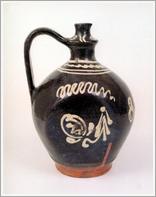

| | 
|
| |
"pot, ""fazék"""
Origin: Békéscsaba Technique: Glazed ceramics with coloured flowers Size: H: 25 cm Bottom: 20 cm |
|


| | 
|
| |
"pot, ""fazék"""
Origin: Szarvas Technique: One handled, bellied, yellow-glazed storing pot with run ornaments. Size: H: 20 cm Bottom: 23 cm |
|
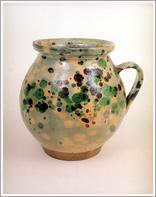

| | 
|
| |
"pot, ""fazék"""
Origin: Békéscsaba Technique: Green-glazed ceramic pot with brown, white yellow flowers. Size: H: 17 cm Bottom: 15 cm |
|
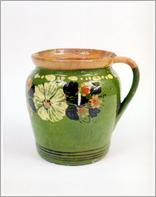

| | 
|
| |
"pot, ""fazék"""
Origin: Békéscsaba Technique: Green-glazed bellied storing pot with wide bottom. Size: H: 14.5 cm Bottom: 15 cm |
|


| | 
|
| |
"pot, ""fazék"""
Origin: Békéscsaba Technique: Yellow-glazed pot with run ornaments. Size: 20 cm Bottom: 23 cm |
|


| | 
|
| |
baking tin
Origin: Nagybánhegyes Technique: Green-glazed outside, brown inside with a pouring lip, wired, fingerprinted ornaments on the upper edge. Size: H: 10 cm L: 40 cm W: 23 cm |
|
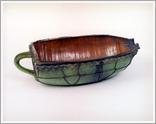

| | 
|
 |
1-20 / 73 |  |
|
|
|
